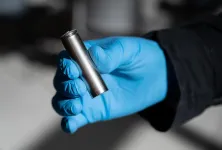(Press-News.org) Hamilton, ON (March 8, 2021) - An analysis of several large studies involving participants from more than 60 countries, spearheaded by researchers from McMaster University, has found that eating oily fish regularly can help prevent cardiovascular disease (CVD) in high-risk individuals, such as those who already have heart disease or stroke.
The critical ingredient is omega-3 fatty acids, which researchers found was associated with a lower risk of major CVD events such as heart attacks and strokes by about a sixth in high-risk people who ate two servings of fish rich in omega-3 each week.
"There is a significant protective benefit of fish consumption in people with cardiovascular disease," said lead co-author Andrew Mente, associate professor of research methods, evidence, and impact at McMaster and a principal investigator at the Population Health Research Institute.
No benefit was observed with consumption of fish in those without heart disease or stroke.
"This study has important implications for guidelines on fish intake globally. It indicates that increasing fish consumption and particularly oily fish in vascular patients may produce a modest cardiovascular benefit."
Mente said people at low risk for cardiovascular disease can still enjoy modest protection from CVD by eating fish rich in omega-3, but the health benefits were less pronounced than those high-risk individuals.
The study was published in JAMA Internal Medicine on March 8.
The findings were based on data from nearly 192,000 people in four studies, including about 52,000 with CVD, and is the only study conducted on all five continents. Previous studies focused mainly on North America, Europe, China and Japan, with little information from other regions.
"This is by far the most diverse study of fish intake and health outcomes in the world and the only one with sufficient numbers with representation from high, middle and low income countries from all inhabited continents of the world," said study co-lead Dr. Salim Yusuf, professor of medicine at the Michael G. DeGroote School of Medicine and executive director of the PHRI.
This analysis is based in data from several studies conducted by the PHRI over the last 25 years. These studies were funded by the Canadian Institutes for Health Research, several different pharmaceutical companies, charities, the Population Health Research Institute and the Hamilton Health Sciences Research Institute.
INFORMATION:
Editors:
For information, please contact:
Veronica McGuire
Media Relations
Faculty of Health Sciences
McMaster University
289-776-6952
vmcguir@mcmaster.ca
Personalised 3D printed models created from cardiac imaging data, mainly from cardiac CT images have been increasingly used in cardiovascular disease, primarily in the preoperative planning and simulation of complex surgical procedures, as well as medical education. 3D printed models are proved to be highly accurate in replicating normal anatomy and cardiac pathology with reported differences less than 0.5 mm between 3D printed models and original sources images. Further to these applications, a new research direction of utilising 3D printed models is to study the optimal CT scanning protocols in cardiovascular disease with the aim of reducing radiation dose while preserving diagnostic image quality. To achieve ...
A new fabrication technique could allow solid-state automotive lithium-ion batteries to adopt nonflammable ceramic electrolytes using the same production processes as in batteries made with conventional liquid electrolytes.
The melt-infiltration technology developed by materials science researchers at the Georgia Institute of Technology uses electrolyte materials that can be infiltrated into porous yet densely packed, thermally stable electrodes.
The one-step process produces high-density composites based on pressure-less, capillary-driven infiltration of a molten solid electrolyte into porous bodies, including multilayered electrode-separator stacks.
"While the melting point of traditional ...
You've heard of animals that can lose and then regenerate a tail or limb. But scientists reporting in the journal Current Biology on March 8 have now discovered two species of sacoglossan sea slug that can do even better, shedding and then regenerating a whole new body complete with the heart and other internal organs. The researchers also suggest that the slugs may use the photosynthetic ability of chloroplasts they incorporate from the algae in their diet to survive long enough for regeneration.
"We were surprised to see the head moving just after autotomy," said Sayaka Mitoh of Nara ...
It's no secret that the United States' $13 billion cannabis industry is big business. Less obvious to many is the environmental toll this booming business is taking, in the form of greenhouse gas emissions from commercial, mostly indoor production.
A new study by Colorado State University researchers provides the most detailed accounting to date of the industry's carbon footprint, a sum around which there is only limited understanding. What is clear, though, is that consumer demand for cannabis is insatiable and shows no signs of stopping as more states sign on to legalization.
The study, ...
The economic benefits of conserving or restoring natural sites "outweigh" the profit potential of converting them for intensive human use, according to the largest-ever study comparing the value of protecting nature at particular locations with that of exploiting it.
A research team led by the University of Cambridge and the Royal Society for the Protection of Birds (RSPB) analysed dozens of sites - from Kenya to Fiji and China to the UK - across six continents. A previous breakthrough study in 2002 only had information for five sites.
The findings, published in the journal Nature Sustainability, come just weeks after a landmark report by Cambridge Professor Partha Dasgupta called for the value of biodiversity to be placed at the heart of global economics.
For the latest ...
Coastal populations are experiencing relative sea-level rise up to four times faster than the global average - according to new research from the University of East Anglia.
A new study published today in Nature Climate Change is the first to analyse global sea-level rise combined with measurements of sinking land.
The impact of subsidence combined with sea-level rise has until now been considered a local issue rather than a global one.
But the new study shows that coastal inhabitants are living with an average sea level rise of 7.8 mm - 9.9 mm per year over the past twenty years, compared with a global average rise of 2.6mm a year.
And the impacts are far larger than the global numbers reported ...
LA JOLLA--(March 8, 2021) Deep learning is a potential tool for scientists to glean more detail from low-resolution images in microscopy, but it's often difficult to gather enough baseline data to train computers in the process. Now, a new method developed by scientists at the Salk Institute could make the technology more accessible--by taking high-resolution images, and artificially degrading them.
The new tool, which the researchers call a "crappifier," could make it significantly easier for scientists to get detailed images of cells or cellular structures that have previously been difficult to observe because they require low-light conditions, such as mitochondria, which can ...
What The Study Did: Researchers assessed the number of hospital admissions for noncommunicable diseases (abnormal tissue growths, metabolic diseases, cardiovascular diseases and musculoskeletal diseases) in São Paulo, Brazil, between January and June last year compared with the corresponding periods in the previous three years.
Authors: Fernando Adami, Ph.D., of the Laboratório de Epidemiologia e Análise de Dados, Centro Universitário Saúde ABC in São Paulo, Brazil, is the corresponding author.
To access the embargoed study: Visit our For The Media website at this link https://media.jamanetwork.com/
(doi:10.1001/jamanetworkopen.2021.0799)
Editor's Note: Please ...
Menlo Park, Calif. -- Scientists have taken a major step forward in harnessing machine learning to accelerate the design for better batteries: Instead of using it just to speed up scientific analysis by looking for patterns in data, as researchers generally do, they combined it with knowledge gained from experiments and equations guided by physics to discover and explain a process that shortens the lifetimes of fast-charging lithium-ion batteries.
It was the first time this approach, known as "scientific machine learning," has been applied to battery cycling, said Will Chueh, an associate ...
Hamilton, ON (March 8, 2021) - Many parents know the struggle of having to make children with pneumonia finish the usual 10-day course in antibiotics despite the child feeling better after a few days of medication.
New research from McMaster University has proven that a five-day course of high-dose amoxicillin will do just as well for children six months to 10 years old with common pneumonia.
"Several studies have proven that adults with pneumonia do fine with short courses of antibiotics, and now we have proved a short course of antibiotics also works for children," said Dr. Jeffrey ...


